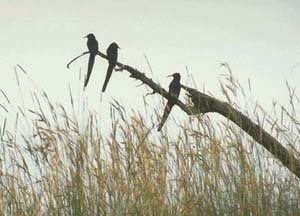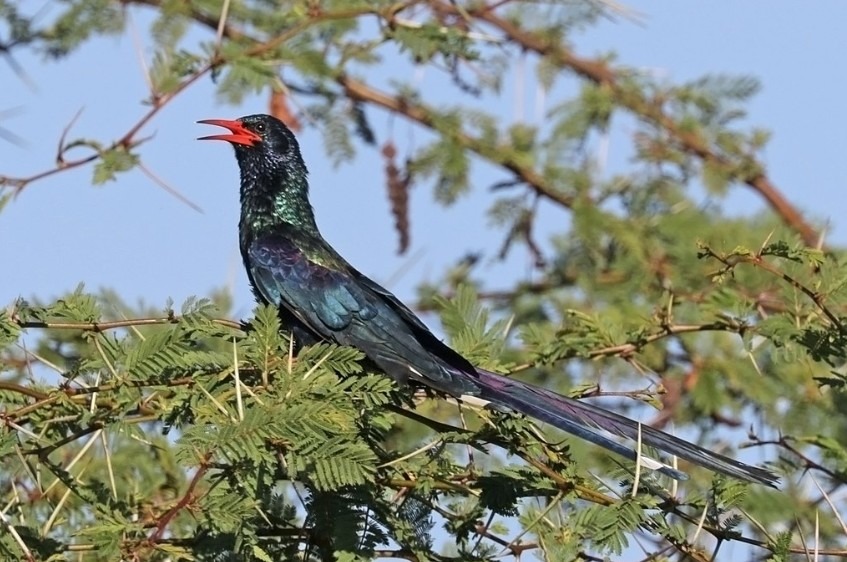It is a long, metallic green-and-black bird with a distinct elongated, retrorse, red-orange bill, and red feet. This bird is a hefty flier, with its lengthy, saggy, white-tipped tail swinging loosely while in flight. Pretty gregarious, pairs and small flocks of up to 14 individuals can be seen thriving in woodlands, savannas, gardens, and riverine forest, and roosting and nesting in natural cavities.
Read further to know more about the Red-billed Wood hoopoe.
What is a Green Wood Hoopoe?
Green Wood Hoopoe (Phoeniculus purpureus), formerly known as the red-billed wood hoopoe, is a long, tropical bird belonging to the Phoeniculidae family of wood hoopoes. This near-passerine bird species in native to Africa, widespread throughout its range and not currently threatened.
Its seven levels of classification are as follows:
Kingdom: Animalia
Phylum: Chordata
Class: Aves
Order: Bucerotiformes
Family: Phoeniculidae
Genus: Phoeniculus
Species: P. purpureus
Green Wood Hoopoe Physical Description
Green Wood Hoopoes are long birds, growing approximately 12.9 to 17.3 inches or 33 to 44 centimeters, and weigh around 52 to 99 grams.
Adult plumage shows a dark green plumage in most of the body, with soft lusters of green, purple, blue, and black. Their head and throat are bluer, the upper mantle is blue, while the nape has a violet tone. A white wingbar occurs on the upperwings along the center of the primaries, while the main tectrices are white-tipped. Their relatively long tails display subterminal marks. The long, decurved bill is red, while short legs and powerful feet are also reddish. Eyes are dark brown.
Both sexes look similar, but the female is smaller and has a shorter bill. Offsprings sport a paler plumage, dark and straighter bill, while legs and feet are blacking too. Throat can also be buff, and white spots on the tails can appear smaller.
Where can they be spotted?
Green Wood Hoopoes are spread throughout Africa and thrive in various habitats, such as thickets, forest edges, and woodlands. They may also occur in palm groves, wooded gardens, and savannas, ranging from the near-sea level or locations up to 2000 meters in elevation. These birds don’t prefer dry, arid areas and prefer natural cavities for nesting and roosting. While mostly resident, seasonal movements can be seen in West Africa.
Interesting Facts You Should Know About the Green Wood Hoopoe
Green Wood Hoopoes’ diet revolves primarily on arthropods, such as moths, beetles, butterflies, bugs, termites, grasshoppers, wasps, bees, crickets, damselflies, and dragonflies. Other food items it consumes include spiders, lizards, and occasionally, acacia and different berry seeds.
These birds usually forage on branches and trunks, aided by their short legs and powerful claws. It will use its long, strong bill to knock off tree barks as it probes for invertebrates. While it prefers to forage in trees, the species can also hawk prey in flight, especially when termites are swarming.
Green Wood Hoopoes are pretty gregarious, aggregating in flocks consisting of 12 to 15 birds. They conduct social displays regarded as “rally” in which they can be seen perching close to each other, half extending their wings, swinging their tails up and down, rocking themselves back and forth, and producing extended, noisy “kuk-uk-uk-uk” sounds. Such displays happen during territorial disputes with other flocks, or when members of the group reunite, strengthening the flocks’ cohesion.
These birds are monogamous. However, only the alpha adults breed within the flock. Other non-breeding individuals help feed the female during the incubation and tend to the chicks and supply them food during the nestling period.
Breeding season is often signaled by the rain in its tropical areas, while breeding activities can happen all throughout the year in other parts of its range. The alpha male and female spend time outside the group prior to nesting, perching together, engaging in mutual preening, and copulation.
These birds don’t build nests but will use cavities as their nesting sites. The female will lay a clutch of 3-4 eggs, which she will solely incubate for 17-18 days as her mate and helpers feed her. After hatching, the broods will still be fed by the group and will fledge approximately 28-30 days but will take 3-4 months before they can fly tenaciously. Juveniles usually remain in the flock for about five years more.
Green Wood Hoopoes are common and abundant throughout its wide range and in its suitable habitats. They are not globally threatened and currently evaluated as Least Concern (LC) under the IUCN Red List.
WILDLIFE PARKS AND RESERVES WHERE THIS SPECIES IS FOUND:
BOTSWANA
SOUTH AFRICA
Kalahari Gemsbok National Park
NAMIBIA
ZAMBIA
ZIMBABWE
BOTSWANA BIRDS | SOUTH AFRICA BIRDS
NAMIBIA BIRDS | ZAMBIA BIRDS | ZIMBABWE BIRDS


